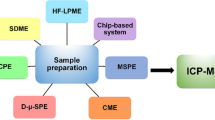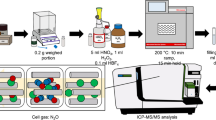Abstract
In theory, state of the art inductively coupled plasma mass spectrometry (ICP–MS) instrumentation has the prerequisite sensitivity to carry out multi-elemental trace analyses at sub-ng L−1 to sub-pg L−1 levels in solution. In practice, constraints mainly imposed by various sources of contamination in the laboratory and the instrument itself, and the need to dilute sample solutions prior to analysis ultimately limit detection capabilities. Here we review these sources of contamination and, wherever possible, propose remedial strategies that we have found efficacious for ameliorating their impact on the results of multi-elemental trace analyses by ICP–MS. We conclude by providing a list of key points to consider when developing methods and preparing the laboratory to routinely meet the demands of multi-elemental analyses at trace analytical levels by ICP–MS.

Similar content being viewed by others
References
Zief M, Speights R (1972) Ultrapurity: methods and techniques. Dekker, New York
Field P, Sherell RM (2003) Direct determination of ultra-trace levels of metals in fresh water using desolvating micronebulization and HR-ICP–MS: application to Lake Superior waters. J Anal At Spectrom 18:254–259
Krachler M, Zheng J, Fisher D, Shotyk W (2005) Analytical procedures for improved trace element detection limits in polar ice from Arctic Canada using ICP–MS. Anal Chim Acta 530:291–298
Dick D, Wegner A, Gabrielli P, Ruth U, Barbante C, Kriews M (2007) Rare earth elements determined in Antarctic ice by inductively coupled plasma—time of flight, quadrupole and sector field-mass spectrometry: an inter-comparison study. Anal Chim Acta 621:140–147
Gabrielli P, Barbante C, Boutron C, Cozzi G, Gaspari V, Planchon F, Ferrari C, Turetta C, Hong S, Cescon P (2005) Variations in atmospheric trace elements in Dome C (East Antarctica) ice over the last two climatic cycles. Atmos Environ 39:6420–6429
Marteel A, Gaspari V, Boutron CF, Barbante C, Gabrielli P, Cescon P, Cozzi G, Ferrari CP, Dommergue A, Rosman K, Hond SM, Hur SD (2009) Climate-related variations in crustal trace elements in Dome C (East Antarctica) ice during the past 672 kyr. Clim Change 92:191–211
Shabani MB, Shiina Y, Kirscht FG, Shimanuki Y (2003) Recent advanced applications of AAS and ICP–MS in the semiconductor industry. Mater Sci Eng B102:238–246
Balram V (2005) Recent developments in analytical techniques for characterization of ultra pure materials–an overview. Bull Mater Sci 28:345–348
Takahashi J (2006) Determination of impurities in semiconductor grade hydrochloric acid using the Agilent 7500cs ICP–MS. http://www.agilent.com/chem. Accessed 10 June 2009
De Mattos JCP, De Moraes Flores EM, Krivan V (2008) Trace element analysis of silicon nitride powders by direct solid sampling graphite furnace atomic absorption spectrometry. J Anal At Spectrom 23:931–937
Matschat R, Heninrich HJ, Czerwensky M, Kuxenko S, Kipphardt H (2005) Multielement trace determination in high purity advanced ceramics and high purity metals. Bull Mater Sci 28:361–366
Sarmiento-Gonzales A, Marchante-Gayon JM, Tejerina-Lobo JM, Paz-Jimenez J, Sanz-Medel A (2008) High-resolution ICP–MS determination of Ti, V, Cr, Co, Ni, and Mo in human blood and urine of patients implanted with a hip or knee prosthesis. Anal Bioanal Chem 391:2583–2589
Rodushkin I, Ödman F, Olofsson R, Axelsson MD (2000) Determination of 60 elements in whole blood by sector field inductively coupled plasma mass spectrometry. J Anal At Spectrom 15:937–944
Heitland P, Köster HD (2006) Biomonitoring of 30 trace elements in urine of children and adults by ICP–MS. Clin Chim Acta 365:310–318
Heitland P, Köster HD (2007) Biomonitoring of 37 trace elements in blood samples from inhabitants of northern Germany by ICP–MS. J Trace Elem Med Biol 20:253–262
Becker JS (2007) Inorganic mass spectrometry: principles and applications. Willey, New York
Keith LH, Libby RA, Crummett W, Taylor JK, Deegan J Jr, Wentler G (1983) Principles of environmental analysis. Anal Chem 55:2210–2218
CDER (Center for Drug Evaluation and Research) (2001) Guidance for industry: bio-analytical method validation, U.S. Food and Drug Administration p 6. http://www.fda.gov/downloads/Drugs/GuidanceComplianceRegulatoryInformation/Guidances/UCM070107.pdf. Accessed June 27 2009
Rodushkin I, Ödman F (2001) Assessment of the contamination from devices used for sampling and storage of whole blood and serum for element analysis. J Trace Elem Med Biol 15:40–45
Benkhedda K, Lariviere D, Scott S, Evans D (2005) Hyphenation of flow injection on-line preconcentration and ICP–MS for the rapid determination of 226Ra in natural waters. J Anal At Spectrom 20:523–528
Grinberg P, Willie S, Sturgeon R (2005) Determination of U, Th and Pu in natural waters, biological materials and clinical samples by ETV-CP-MS. J Anal At Spectrom 20:717–723
Nygren U, Rodushkin I, Nilsson C, Baxter DC (2003) Separation of plutonium from soil and sediment prior to determination by inductively coupled plasma mss spectrometry. J Anal At Spectrom 18:1426–1434
Thomas R (2002) A beginner’s guide to ICP–MS: part XII-A review of interferences. Spectrosc 17:24–31
Riondato J, Vanhaecke F, Moens L, Dams R (2000) Fast and reliable determination of (ultra-)trace and/or spectrally interfered elements in water by sector field ICP–MS. J Anal At Spectrom 15:341–345
Vanhaecke F (2002) ICP–MS Alternative means for the elimination of interferences. Anal Bioanal Chem 372:20–21
Begley IS, Sharp BL (1997) Characterisation and correction of instrumental bias in inductively coupled plasma quadrupole mass spectrometry for accurate measurement of lead isotope ratios. J Anal At Spectrom 12:395–402
Pappas RS, Stanfill SB, Watson CH, Ashley DL (2008) Analysis of toxic metals in commercial moist snuff and Alaska Iqmik. J Anal Toxic 32:281–291
Rodushkin I, Ruth T (1997) Determination of trace metals in estuarine and sea-water reference materials by high resolution inductively coupled plasma mass spectrometry. J Anal At Spectrom 12:1181–1185
Riondato J, Vanhaecke F, Moens L, Dams R (1997) Determination of trace and ultratrace elements in human serum with a double focusing magnetic sector inductively coupled plasma mass spectrometer. J Anal At Spectrom 12:933–937
Thirlwall M (2001) Inappropriate tail corrections can cause large inaccuracy in isotope ratio determination by MC-ICP–MS. J Anal At Spectrom 16:1121–1125
Rodushkin I, Lindahl P, Holm E, Roos P (1999) Determination of plutonium concentrations and isotope ratios in environmental samples with a double-focusing sector field ICP–MS. Nucl Instrum Methods Phys Res 423A:472–479
Helal AI, Zahran NF, Amr MA, Abd El-Lateef AM, Bashter II, Mohsen HT, Abbas Y (2004) Ultratrace and isotope ratios analyses of some radionuclides by ICP–MS. Radiochim Acta 92:369–374
Engström E, Stenberg A, Senioukh S, Edelbro R, Baxter DC, Rodushkin I (2004) Multi-element characterization of soft biological tissues by inductively coupled plasma-sector field mass spectrometry. Anal Chim Acta 521:123–135
Mahar MM, Tyson JF, Neubauer K, Grosser X (2008) High throughput sample introduction system for the analysis of drinking water and wastewaters by ICP–MS. J Anal At Spectrom 23:1204–1213
Minnich MG, Miller DC, Parsons PJ (2008) Determination of As, Cd, Pb, and Hg in urine using inductively coupled plasma mass spectrometry with the direct injection high efficiency nebulizer. Spectrochim Acta 63B:389–395
Cho T, Akabane I, Murakami Y (1990) Basic study on the application of tetramethylammonium hydroxide (TMAH) alkaline digestion for the determination of some volatile elements by ICP–MS. In: Jarvis KE, Gray AL, Williams JG (eds) Plasma source mass spectrometry: the proceedings of the third surrey conference on plasma source mass spectrometry. Royal Society of Chemistry, London, pp 94–119
Malinovsky D, Rodushkin I, Baxter DC, Öhlander B (2002) Simplified method for the Re-Os dating of molybdenite using acid digestion and isotope dilution ICP–MS. Anal Chim Acta 463:111–124
Andrén H, Rodushkin I, Stenberg A, Malinovsky D, Baxter DC (2004) Sources of mass bias and isotope ratio variation in multi-collector ICP–MS: optimization of instrumental parameters based on experimental observations. J Anal Atom Spectrom 19:1217–1224
Burman JO, Pontér C, Boström K (1978) Metaborate digestion procedure for inductively coupled plasma-optical emission spectrometry. Anal Chem 50:679–680
Ultra-clean sampling for waters, soil/sediments, and tissues. http://frontiergeosciences.com. Accessed 28 July 2009
Krachler M, Heisel C, Kretzer JP (2009) Validation of ultratrace analysis of Co, Cr, Mo and Ni in whole blood, serum and urine using ICP-SMS. J Anal Atom Spectrom 24:605–610
Rodushkin I, Engström E, Sörlin S, Baxter DC (2008) Levels of inorganic constituents in raw nuts and seeds on the Swedish market. Sci Total Environ 392:290–304
Rodushkin I, Engström E, Stenberg A, Baxter DC (2004) Determination of low-abundance elements at ultra-trace levels in urine and serum by inductively coupled plasma-sector field mass spectrometry. Anal Bioanal Chem 380:247–257
Author information
Authors and Affiliations
Corresponding author
Rights and permissions
About this article
Cite this article
Rodushkin, I., Engström, E. & Baxter, D.C. Sources of contamination and remedial strategies in the multi-elemental trace analysis laboratory. Anal Bioanal Chem 396, 365–377 (2010). https://doi.org/10.1007/s00216-009-3087-z
Received:
Revised:
Accepted:
Published:
Issue Date:
DOI: https://doi.org/10.1007/s00216-009-3087-z




